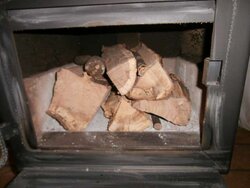Hello A M and others. That if I'm not mistaken is not a crack - just like Eric said - it's a seam, my stove (Baltic - exact same stove as yours but with legs instead of a pedestal.) has the exact same seam on it. In fact if I remember right (I'm not home so can't look at it to confirm) there's more then one of those around the front perimeter if you look closely?
These stoves are not CAT stoves. The bypass serves a couple functions - one helps warm up the chimney quickly when lighting a cold stove. Secondly when reloading the stove it's a good idea to open the bypass as that stops any smoke from exiting out the door.
I leave the bypass open when warming up the stove till the chimney thermometer (which you don't have!) hits 550-600f. I think the stove top is usually around the 400-450f temp at that point.
Be aware if you're not careful a split can cause the by-pass to not close properly. I always check it as soon as I've loaded the wood in and if it hits I reposition the offending chunk accordingly.
Once the by-pass is closed I continue to monitor the stove top temps and once they hit 500 I pretty much close the door. The primary air damper remains wide open.
Now again because I have a chimney thermometer I monitor it and while the stove top continues to warm up with 600f+ being my goal, if the chimney temp hit's 800f+ then I close the primary air down completely till I see that gauge start to creep back down at which point I open up the primary air vent at least half way or more to get good flames going again in the firebox. I continue to do this till the stove top temp reads 600f+ at which point it's ready to cruise.
Now I close the primary air vent down but not completely. It stays open enough so that both gauges stabilize, usually the chimney temp holds at 600f and the stove top hangs out between 600-700f.
Early post you said you are filling it to the top of the bricks. That's no where near full if that's as full as you're going. Full is within an inch of the top.
These are large stoves (3.1cf firebox) they work better with a large load.
Describe what a medium and a large spilt is for you.
IE my opinion:
Medium: 2.5-4inch diameter log or split.
Large: 4inch plus. Typically 6-8inch is what I normally use.
Now when I load mine to get a long burn it'll have at least 3-6 large chunks in it with at least 3 chunks that are 6inches or larger in diameter. and then a few medium ones as well to help things along. As I almost never start from cold I usually have enough coals left that I don't need anything smaller then a medium chunk.
When my stove gets to the point that it's down to 400f or cooler there isn't anything but coals in there. That's usually after 10-12hrs of burning. If you still have unburnt wood my guess is that you've not got it hot enough and then shut down the primary air control too much to allow it to burn any more.
Hope this helps. Keep at it and fill that box up!!

E.
 ... I'll take a photo of a "full" load BEFORE it begins to burn and record the times and temps I'm seeing.
... I'll take a photo of a "full" load BEFORE it begins to burn and record the times and temps I'm seeing.

